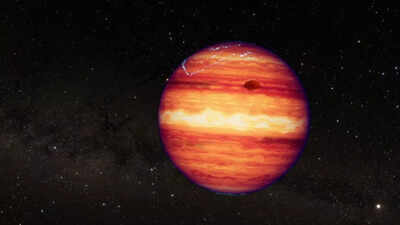- News
- Science News
- NASA’s James Webb Space Telescope unveils complex atmosphere of starless super-Jupiter
NASA’s James Webb Space Telescope unveils complex atmosphere of starless super-Jupiter
Astronomers using the James Webb Space Telescope (JWST) have discovered complex atmospheric changes on SIMP 0136, a free-floating planetary object not orbiting a star. Infrared observations revealed iron-rich clouds, high-altitude silicate clouds, and unusual temperature and chemical fluctuations, offering new insights into gas giants' behavior and aiding the search for habitable exoplanets.
Astronomers with the James Webb Space Telescope (JWST) have discovered something fascinating about SIMP 0136, a gigantic, free-floating planetary object. While most bodies orbit around a star, SIMP 0136 floats on its own in space. New observations confirm a dynamic and complex atmosphere with shifting temperatures, dotted clouds, and mysterious chemical fluctuations. These findings are important milestones of the stormy atmospheres of gas giants elsewhere in the universe.
NASA’s James Webb Telescope discovers the intricate atmosphere shifts
This finding is a milestone in exo-meteorology, or the study of weather on other, distant alien planets. By monitoring SIMP 0136's atmospheric shifts so closely, scientists are making instruments and techniques more precise so that they can study exoplanets more thoroughly. This is an important milestone in determining which planets might be able to support life in the future.
The historic research, available in The Astrophysical Journal Letters, employed precise infrared tracking of SIMP 0136 over many complete rotations. The object, with a mass of approximately 13 times that of Jupiter, is only 20 light-years away in the Milky Way. But while reasonably compact, SIMP 0136 does not revolve around a star, and a number of scientists have determined it to be a brown dwarf—too big to qualify as a planet but too little to support nuclear fusion like a star.

Image source: NASA
Since SIMP 0136 is not orbiting a star, it gives us a straight shot at observing atmospheric activity free from the influence of the light and heat of a star. Cloud patches were what telescope observations from the likes of Hubble and Spitzer had previously indicated, but the cutting-edge infrared of Webb revealed much more intricate situations.
JWST captures detailed atmospheric layers of SIMP 0136
With JWST's NIRSpec (Near-Infrared Spectrograph) and MIRI (Mid-Infrared Instrument), scientists took thousands of infrared snapshots as SIMP 0136 rotated once on its entire orbit. Snapshots showed several layers of atmospheres with distinct properties:
- Iron-rich clouds at low latitudes: Lower layers are characterized by irregularly distributed iron particulate clouds which come and go as the globe rotates.
- High-altitude silicate clouds: Besides the iron-rich clouds, researchers also found silicate (rock) particles producing other brightness variations in the atmosphere.
- Enigmatic hot spots and chemical alterations: Higher up in the atmosphere, unusual temperature fluctuations were seen. These could be associated with auroras or hot gas plumes, leading to variations in carbon-based molecule amounts such as methane and carbon monoxide.
SIMP 0136’s atmospheric changes offer new insights for the search for habitability
The atmospheric composition of SIMP 0136 is still a matter of open question. Scientists have documented changes in carbon compounds such as methane and carbon dioxide that can develop over time and along the surface of the body.
"We have not yet worked out the chemistry," said Trinity College Dublin principal investigator Johanna Vos. "But these findings are intriguing in that they suggest that the existence of molecules such as methane and carbon dioxide may vary both in space and time.".
SIMP 0136 is giving us much insight into gas giants' behavior, which reside in orbits so close to their parent stars as to be untenable for extended atmospheric observation. The results describe how the atmosphere of an exoplanet changes over time and indicate that one observation may not be representative of its chemical make-up. This is of keen interest to the search for habitable planets.
"If we are only able to get one measurement of an exoplanet, we must consider that it is not the entire planet," said Vos.
As NASA's Nancy Grace Roman Space Telescope is going to be released in 2027 and the Extremely Large Telescope on our planet is currently under construction, scientists feel confident that they can apply these findings to image exoplanets directly. They will lead us to a sight of possible traces of habitability and, ultimately, life off the planet Earth.
Also Read | 10 NASA’s greatest achievements

About the Author
TOI Science DeskEnd of Article
FOLLOW US ON SOCIAL MEDIA

